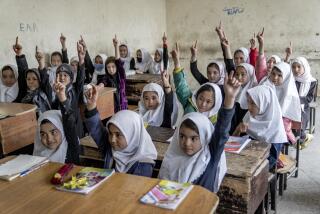Modernization Plan Moves China Away From Bombs and Toward Books
- Share via
PEKING — China’s defense industry is turning from bombs to bicycles and from rockets to refrigerators. Under a new law, children are required to complete nine grades of school.
The production of consumer goods in arms factories and the new compulsory education law are two more strides in the Communist government’s goal of turning China and its 1 billion people into a modern, forward nation by the turn of the century.
The Ordnance Industry Ministry says one-third of its production lines now are turning out non-military goods worth an annual $800 million. By 1990, it plans for two-thirds of its output to be in civilian products.
That would put China a long way from the days of Chairman Mao Tse-tung, whose revolutionary creed was that “political power grows out of the barrel of a gun.”
New Objectives
Today, under the leadership of Deng Xiaoping, economic power, education and literacy are top objectives in bringing advancements to China.
“Our people feel they are working for their country, and that it is all revolutionary work,” said Gao Weiqiang, head of a factory that once made explosives and now makes clocks.
Gao said two-thirds of production at the 1,000-worker factory is now geared to making 200,000 clocks a year. Eventually the plant will abandon explosives completely, although the timing for the turnover will depend on “our assessment of the market for clocks,” he said.
At a recent trade fair in Peking, Gao and representatives of several hundred other armaments factories exhibited a wide range of consumer goods: bicycles, motorcycles, refrigerators, toys, beds, heaters, snowmobiles, shoes, beer. They also showed trucks, engines, communications equipment and an armored personnel carrier turned into a firefighting vehicle--all converted from military use.
Defense Industry Changing
Zhao Yuzhou said part of his tank factory in Inner Mongolia now produces, by special order, classical marble and ceramic statues for parks and government centers.
Tao Sen said his factory at Kunming in southern China has switched from bombs to “Spring Flower” bicycles.
The industry’s switch to consumer goods began around 1980, shortly after the Deng government decided that China must turn from a history of political turmoil and dedicate itself to developing its economy through market-force principles, private initiative and other far-reaching reforms, such as education.
Defense spending has since been held down, and will constitute 9.1% of the state budget in the 1986-90 period, compared to 13.1% in the 1981-85 five-year plan.
Output Is Booming
Premier Zhao Ziyang said earlier this year that defense industries boast some of the country’s best scientists and engineers, and the question is how to put these industries and their equipment to work for the country’s modernization drive in civil production.
Last year, according to the Ordnance Industry Ministry, output included 1.97 million bicycles, 1.3 million motorcycles, 2 million washing machines, 5,500 motor vehicles and 500,000 cameras.
The industry now produces 700 types of goods, up from 64 in 1980, on more than 200 assembly lines around the country.
The law requiring nine grades of education for China’s 170 million school-age children, about four times the elementary and high school enrollment in the United States, went into effect July 1.
Literacy Is Essential
The National Peoples Congress, in passing the law in the spring, said keeping children in school is essential, especially in rural areas, to overcome illiteracy in particular and achieve modernization goals in general.
Government figures indicate that one person in every four of China’s 800 million rural residents is illiterate or semi-literate.
“Enforcing compulsory education will be an enormous task,” said Wen Xiaojie, a deputy division chief in the secondary education department of the Education Ministry. “We are going to need to amass a large amount of money.”
China, nevertheless, has already come a long way in educating its people. According to ministry figures, only 20% of school-age children were enrolled when the Communists took over in 1949. Last year, 95.9% completed the six grades of primary school, and two-thirds of those went on to three-year middle school. Its overall literacy rate is 75%.
School Fees a Problem
Education, however, remains woefully weak in some remote areas.
In one county in southern Hunan province, only 45% of the students finish primary school, according to the official English-language newspaper China Daily. Many drop out because their families can’t afford fees of 1.5 yuan (about 40 cents) a term.
Only 30% to 40% of children go to school in Tibet and Qinghai in China’s far west.
In rural Fujian Province, a survey indicated that 6.2% of primary school children leave school to help on the family farms or businesses, and the dropout rate is particularly high among girls hired by factories as seasonal workers.
Compulsory Education
Ironically, China’s decision to let farmers sell their own crops, a key element in the modernization program, has accelerated the flight from school, said Ji Zhiojian, deputy director of the elementary education department in the Education Ministry.
“When the reform policy was initiated, many peasants withdrew their children from school to help them get rich quickly,” he said. But that problem has slackened considerably, he added, and under the new education law, any organization or individual recruiting school-age children will be reprimanded. In serious cases, fines will be imposed and operating licenses revoked.
Girls, who seldom received schooling before the modernization era, still make up only 43.8% of elementary school pupils. Females make up 70% of the rural illiterate or semiliterate.
Compulsory education will also require a major upgrading of the quality and number of the nation’s teachers. The state-run newspaper Guangming Daily recently estimated that 3 million out of 8.4 million elementary and middle-school teachers are underqualified, a result of poor training and low job status.
A Five-Year Plan
Wen said the 1986-90 five-year plan provides funding for more teacher training programs. A new television channel to aid teachers went on the air July 1. Teams are being sent out to help teachers in isolated areas and incentives are being offered for college graduates to teach in the countryside.
Teachers were given a salary increase last year, but they still earn only about 100 yuan ($27) a month, about the same as a factory worker.
China has budgeted the yuan equivalent of $31.5 billion for education during the 1986-90 period, up 72% from the previous five-year plan. Included is $351 million for teacher training and improving conditions in country schools.
More to Read
Sign up for Essential California
The most important California stories and recommendations in your inbox every morning.
You may occasionally receive promotional content from the Los Angeles Times.










